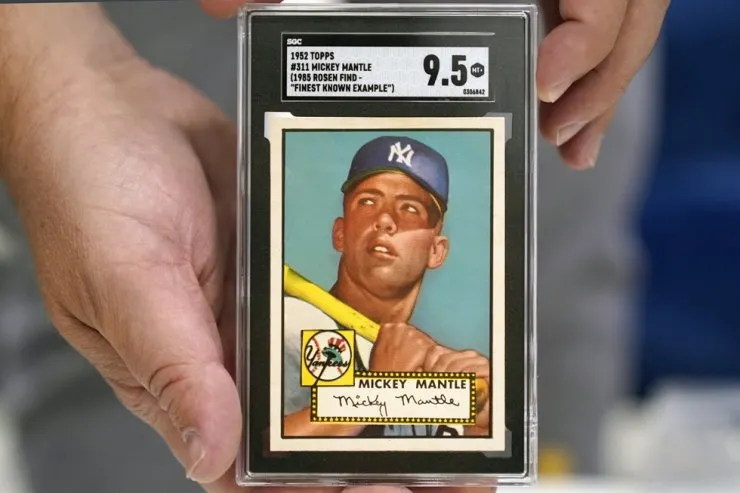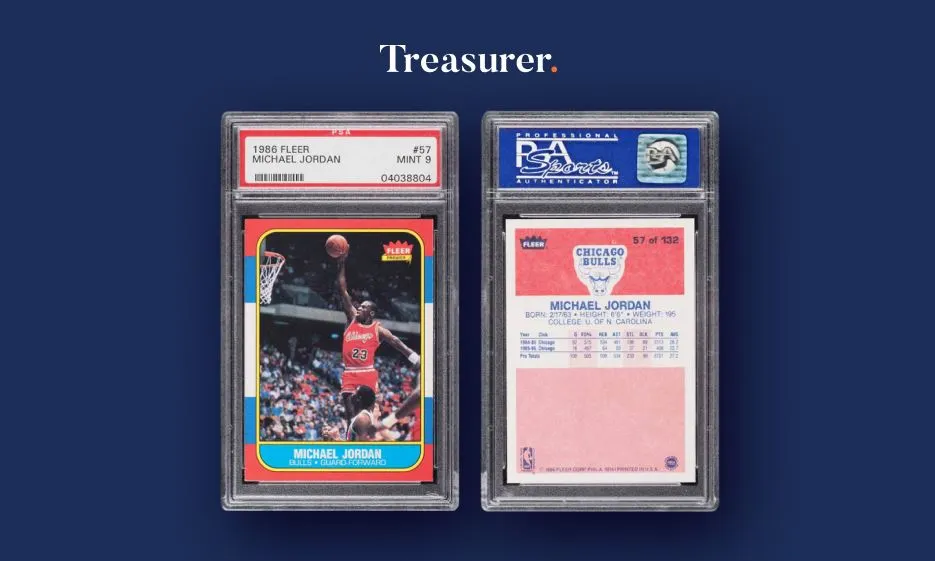A staffer at Heritage Auction shows a sports card featuring Mickey Mantle in Dallas, U.S., in this July 2022 file photo. The card was sold for a record-breaking $12.6 million, marking the highest price ever paid for a piece of sports memorabilia. AP-Yonhap
Seasoned collectors turn hobby into profit, newcomers buy way into sports card investing game
By Lee Yeon-woo
"Hello, this is the bank. We are contacting you to confirm a recent deposit made into your account from the U.S. exceeding $20,000. Could you verify the purpose of this transaction?"
Koo Ja-kyung, a dentist based in Daejeon who received the call, responded in a surprisingly composed manner. "I recently auctioned a sports card I owned in the U.S., and it seems like the proceeds from the auction have been transferred."
With over 30 years of collecting experience under his belt, Koo said he had already anticipated a substantial return from that single sports card.
"The liquidity surge driven by COVID-19 has impacted not only the stock markets but also the world of sports cards," he explained. During the time, the price of a Fleer rookie card featuring basketball superstar Michael Jordan skyrocketed to more than $100,000, from its previous trading price hovering around $50,000.
Capitalizing on this trend, five months later, Koo sold off a card featuring basketball star Kevin Durant, which he had owned for over a decade.
Koo Ja-kyung, a sports card collector and the author of "The World of Sports Cards: From Collecting to Investment," poses beside his collection of sports cards and memorabilia, and his book, at his dental clinic in Daejeon, Wednesday. Courtesy of Koo Ja-kyung
Koo is not the only one who has turned an old hobby into an investment strategy.
"There are many sports card enthusiasts in Korea who have been collecting for years. Lately, a significant number of sports lovers have entered the market as they realize these cards can be a viable investment. With YouTube broadening access to information outside Korea, it's also relatively easy to research relevant information," Koo said in a recent video interview with The Korea Times.
Park Ji-hwan, another fervent collector with 28 years of experience, agreed. Seeing the market potential, he even left his job and opened a store in 2021. His store, Legacy Sports Card Shop, is located near Yatap Station in Bundang, Seongnam City, Gyeonggi Province.
"I felt that the world of sports card collecting is transitioning into an investment field. Having collected cards for so long, I wanted to advise and guide newcomers," Park said. His primary clientele are in their 30s and 40s along with a few teenagers visiting the shop with their parents.
Owner of Legacy Sports Card Shop, Park Ji-hwan, poses during an interview at his store in Bundang, Seongnam City, Gyeonggi Province, July 25. Korea Times photo by Lee Yeon-woo
Indeed, the world of sports cards is becoming more profitable.
"If an investment was made in the U.S. S&P 500 index in 2008, the return on that investment would be approximately 175 percent by 2022. However, the returns from the PWCC500 index, which is based on the final auction prices of the top 500 popular sports cards on a U.S. sports card auction site, are substantially higher, reaching a staggering 855 percent by 2022," Koo wrote in his book titled "The World of Sports Cards: From Collecting to Investment."
In July 2022, a card featuring all-time baseball legend Mickey Mantle, produced in 1952 by Topps, was sold for a record-breaking $12.6 million, marking the highest price ever paid for a piece of sports memorabilia.
The market is heating up even more as more national sports stars break into the American or European markets. "There's a shortage of Lee Kang-in's cards (a Korean midfielder who recently transferred to Paris Saint-Germain) due to their popularity among Koreans," Park said.
It can be challenging for newcomers to invest in the high-priced cards that virtually guarantee high returns. One enticing option for young Koreans is to purchase fractional ownership of high-value cards featuring superstar athletes.
For example, Treasurer, a Korean company that sells shares in expensive collectibles, started offering ownership stakes in a Fleer 1986 Michael Jordan card in June.
A promotional image from Treasurer / Courtesy of Treasurer
Sports cards are not a recent phenomenon, even in Korea. Korea first discovered sports cards in the mid-1990s, around the time when the National Basketball Association (NBA) and the popularity of Michael Jordan captivated the nation.
"There used to be many bricks-and-mortar shops scattered around. After school, students would typically buy and trade cards. Now these shops are primarily located in Seoul and Gyeonggi Province. However, back then, they were distributed nationwide. Even department stores had sports card shops," Koo explained.
However, the market nearly collapsed after the Asian financial crisis in 1997. As people struggled to survive, the funds they had available for hobbies, including collecting sports cards, dwindled significantly.
20 years later, the industry made an impressive comeback during the pandemic, with a dramatic surge in prices. While some market observers believe the bubble has burst, collectors maintain a positive outlook.
"No asset only appreciates without experiencing drops or adjustments. However, I believe that valuable sports cards, given their limited quantities, will continue to serve as a store of value," Koo asserted. "Compared to other personal collection investments, collecting sports cards is advantageous as their authenticity, rarity, and condition are relatively easy to verify. Moreover, they are less complicated and cheaper to store."
Park echoed Koo's sentiment, adding that, in the long term, the value of sports cards is undeniably rising.
"Beyond the financial value of the cards, collecting sports cards is appealing because it allows you to support and cheer on your favorite athletes. But the greatest thrill comes when a card you've purchased earlier ― recognizing the player's potential ― gains recognition and value in the eyes of others down the line," Park explained.
A staffer from Goldin Auctions looks at a sports card featuring LeBron James in a reality show "King of Collectibles: The Goldin Touch." Screenshot from Netflix YouTube
Collectors explain that the key to a successful investment is identifying an athlete who has the potential to become a superstar someday. For instance, a rookie card of Michael Jordan, now worth approximately $200 million, could have been purchased for just $5 in 1986.
"It's not just about luck. Having the ability to spot a player's potential and a discerning eye to read macroeconomics trends are key to making a stable investment," Koo said.
Another crucial factor is to keep the card in pristine condition. Even the slightest scratch or crumpled edge could depreciate the card's value by millions of won.
"You have to handle cards with extreme care when unboxing. If you plan to keep them for an extended period, it's best to send them to a card grading company as soon as possible (so they can encapsulate and protect the card)," Park explained.
However, the most important factor is to approach the market as a sports enthusiast, not just an investor.
"If you enter the market solely for financial gain, you won't recover if you encounter a loss. The journey should start with collecting, not investing, and any money spent should be within the bounds of what brings you joy," Park added.
original article source: https://www.koreatimes.co.kr/www/biz/2023/08/602_355871.html






